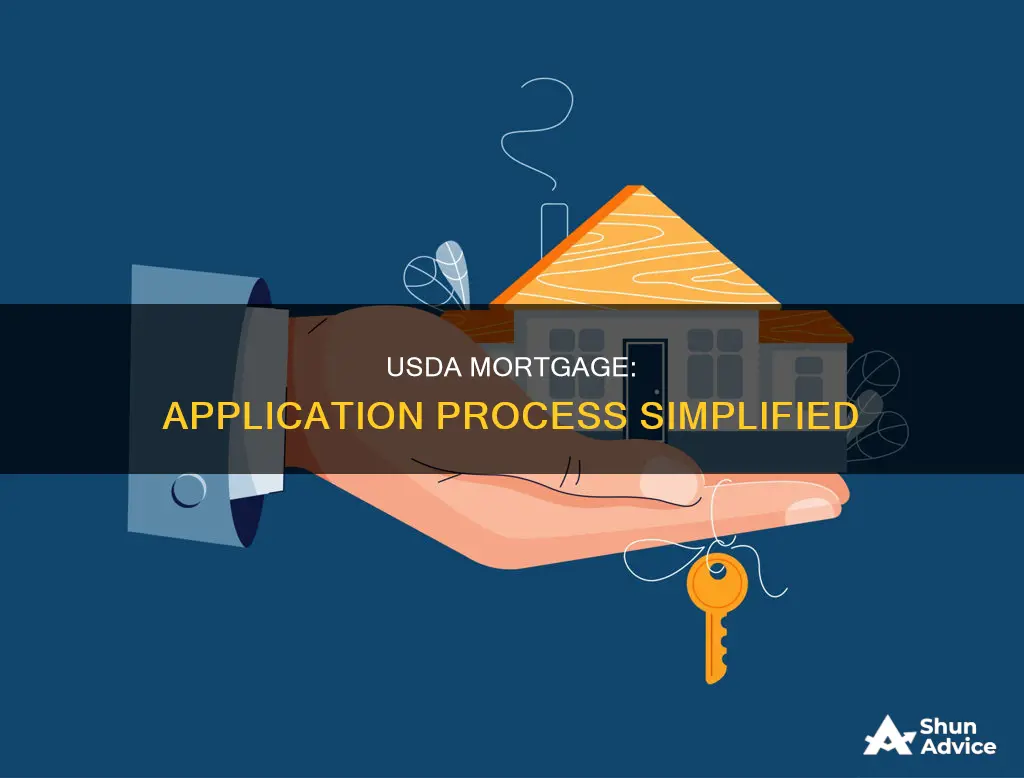
USDA loans are government-backed mortgages designed for low- to moderate-income borrowers in rural and suburban areas. The USDA loan application process can be started online or in person and typically takes 30-45 days from prequalification to closing and approval. Applicants can apply for a Section 502 Guaranteed Loan through USDA Rural Development's network of approved lenders, who will determine eligibility and guide them through the application process. To qualify, applicants must meet income requirements, be a US citizen, US non-citizen, or qualified alien, and purchase a home in an eligible rural area.
| Characteristics | Values |
|---|---|
| Loan type | Section 502 Guaranteed Loan |
| Who it's for | Low- and moderate-income households |
| What it's for | Purchasing, building, rehabilitating, improving or relocating a dwelling in an eligible rural area |
| Down payment | No down payment required |
| Loan amount | No strict loan limits, but based on income and property's appraised value |
| Interest rate | Competitive |
| Mortgage insurance costs | Low |
| Application process | Online or in-person |
| Time to approval | 30-45 days |
| Eligibility requirements | Income, property location, credit history, employment status, debt-to-income ratio |
What You'll Learn

Check eligibility and application process
To check your eligibility for a USDA mortgage and begin the application process, you can start by taking the following steps:
First, determine if you meet the basic eligibility requirements. This includes being a U.S. citizen, U.S. non-citizen national, or Qualified Alien, and intending to purchase a home in an eligible rural area as defined by the USDA. The USDA's Eligibility Site allows you to enter a specific address or search the map to determine whether a property is located in an eligible area.
Next, you should find a USDA-approved lender. Not all lenders are approved by the USDA, so it is important to verify this before proceeding. The USDA Rural Development website provides a list of approved lenders, searchable by state. These lenders will be your point of contact for any questions regarding eligibility and will handle the entire loan application process. It is recommended to comparison shop between lenders to find the best service and financial options available.
Once you have selected a lender, they will outline the specific documents required to verify your income and determine your eligibility. Lenders will consider your total household income, including that of each income-earning adult who will be living with you, as well as your major monthly debts. This information will be used to calculate your debt-to-income ratio (DTI), which helps clarify how much you can afford and how much the lender is willing to lend.
The application process can be started online or in person and typically takes around 30-45 days from prequalification to closing and approval. Getting prequalified with a USDA lender will require a credit check and an income review. Self-employed applicants will generally need to provide two years of income records, while year-round employees will need one year's worth.
Finally, once you have gathered and submitted all the required documentation, work closely with your lender and other parties to expedite the loan approval process. The faster all parties collaborate to complete and provide the necessary documents, the quicker the final loan approval and closing can occur.
Mortgage and Marriage: Adding a Spouse to Home Loans
You may want to see also

Find a USDA-approved lender
When looking for a USDA-approved lender, it is important to find an experienced lender. The USDA maintains a list of approved lenders, which includes online lenders and banks with branches nationwide, as well as small-town banks and credit unions. This list is searchable by state and is regularly updated.
USDA-approved lenders with dedicated teams can provide a better quality customer experience. You can get to know your loan officer throughout the homebuying process. However, other companies might sacrifice personal connection for the sake of efficiency. Depending on your priorities and personal preferences, each set-up has its benefits and drawbacks.
Before starting the homebuying process, it is a good idea to get a general sense of current market interest rates. However, don't get too attached to the rates you see online. The interest rate you ultimately lock in for your USDA loan depends on your credit score, debt-to-income ratio, and other factors.
USDA-approved lenders will consider your total household income in relation to your major monthly debts. They use this debt-to-income ratio (DTI) to clarify how much you can afford and what they are willing to lend you. The front-end ratio considers only your proposed monthly housing cost in relation to the monthly income, while the back-end ratio looks at all major monthly debts, including the new mortgage payment, compared to monthly income.
USDA-approved lenders are your point of contact for any questions or scenarios you wish to have reviewed for possible eligibility.
Adding Your Spouse to Your Mortgage: What You Need to Know
You may want to see also

Prepare your documents
To apply for a USDA mortgage, you will need to prepare a variety of documents to verify your income, debts, and eligibility. Here is a detailed list of what you will need:
- Income documentation: You will need to provide proof of income for all income-earning adults in your household. Self-employed applicants must provide two years of income records, while year-round employees need one year's worth. Lenders will use this information to confirm your income and determine how much you can afford for your monthly housing costs and debts.
- Credit history: A good credit history is essential. Your lender will review your credit score and credit report to identify any red flags or derogatory credit history that may impact your eligibility or loan terms. If your credit score is below 640, your lender may need to manually underwrite your loan before submitting it for USDA approval.
- Employment records: Steady employment is a requirement for a USDA mortgage. You will need to provide documentation that demonstrates your current employment status and history.
- Debt information: In addition to your income, lenders will consider your major monthly debts. They will use your debt-to-income ratio (DTI) to determine your ability to take on a new mortgage. This includes considering your proposed monthly housing costs and all other major monthly debts in relation to your monthly income.
- Property eligibility: The USDA loan is designed for homes in eligible rural or suburban areas. You will need to verify that the property you wish to purchase is located in one of these designated areas. The USDA provides an Eligibility Site where you can check if a specific address or general area is eligible.
- Citizenship status: You must be a U.S. citizen, U.S. non-citizen national, or Qualified Alien to be eligible for a USDA loan. Have your citizenship or residency documentation ready.
- Other state-specific requirements: Depending on the state in which you are applying, there may be additional state-specific requirements. Be sure to check with your local state RD office or a USDA loan specialist to ensure you have all the necessary documentation.
Remember, providing all the required documentation in a timely and complete manner will help streamline the loan approval process.
Assessing Subprime Mortgage Investment: A Comprehensive Guide
You may want to see also

Get pre-approved
To get pre-approved for a USDA mortgage, you must first find a USDA-approved lender. Not all lenders are approved by the USDA, so it is important to check that your chosen lender is on the list of approved lenders. The approved lender will handle the entire loan application process, working with Rural Development staff to ensure your loan is guaranteed by the agency.
USDA-approved lenders can be searched for by state, and the list is kept as up-to-date as possible. It is also recommended to shop around between lenders to find the best service and financial options available.
USDA lenders will request income documentation to confirm your income and eligibility before issuing a pre-approval. They will consider the total household income in relation to your major monthly debts, using the debt-to-income ratio (DTI) to clarify how much you can afford and what they are willing to lend. The front-end ratio considers only your proposed monthly housing cost in relation to monthly income, while the back-end ratio looks at all major monthly debts, including the new mortgage payment, compared to monthly income.
To get pre-approved, you will need to provide income documentation for yourself and each income-earning adult living with you. Self-employed applicants must provide two years of income records, while year-round employees need one year's worth.
The pre-approval process typically takes around 30-45 days, and once pre-approved, you are in a position to make an offer when you find an eligible property.
Applying for a HARP Mortgage: A Step-by-Step Guide
You may want to see also

Understand the loan specifics
To get a USDA loan, you need to understand the specifics of the loan, which include the following:
First, check that you meet the eligibility criteria. The USDA loan is designed for low-to-moderate-income households, so there are income limits, which vary by location. You also need to be a US citizen or permanent resident, and the property you're buying must be located in an eligible rural area, as defined by the USDA.
The USDA offers two types of loans: direct and guaranteed. Direct loans are for low-income applicants and are issued directly by the USDA. Guaranteed loans, on the other hand, are issued by USDA-approved lenders and are for those with higher incomes. The guaranteed loan program is typically more popular due to its less stringent requirements and faster processing times.
USDA loans offer a significant advantage in that they provide 100% financing, meaning you don't need to make a down payment. This is especially beneficial for first-time homebuyers who may not have substantial savings. However, it's important to note that you will still need to budget for closing costs, which can range from 2% to 5% of the loan amount. You have the option to roll these costs into your loan or negotiate with the seller to pay them, depending on market conditions and their willingness to contribute.
Interest rates for USDA loans are generally competitive and remain fixed for the duration of the loan, providing stability and predictability in your payments. Another benefit is the absence of prepayment penalties, allowing you the flexibility to pay off your loan early without incurring additional fees.
Additionally, USDA loans come with annual fees, similar to private mortgage insurance (PMI), which are calculated based on the remaining principal balance of the loan. Specifically, for a purchase loan, the annual fee starts at 0.35% of the loan amount for the first year and gradually decreases annually until it reaches 0.20% from year 11 onwards. These fees serve the purpose of funding USDA programs and ensuring the continuous availability of loans for future homebuyers.
Adding Your Child's Name to Your Mortgage: What You Need to Know
You may want to see also
Frequently asked questions
You can apply for a USDA mortgage online or in person. You will need to work with an accredited lender who will determine eligibility and guide you through the application process.
The USDA mortgage is designed for low- to moderate-income borrowers in rural and suburban areas. The eligibility criteria include being a US citizen, US non-citizen, or qualified alien, and having a good credit history, steady employment, and no recent history of bankruptcy or repossession.
The USDA mortgage offers benefits such as no down payment, competitive interest rates, and lower mortgage insurance costs. It also provides 100% financing and is backed by the federal government.
You will need to provide documents to verify your income, such as income documentation and tax returns. The lender will consider your total household income, including income from each adult earner in the household, and your debt-to-income ratio to determine your eligibility.







